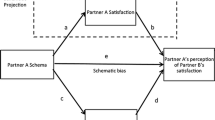Abstract
The Sexual Decision-Making Inventory (SDMI) was developed to measure levels of sexual decision making based on the developmental concepts of Object Relations Theory. The inventory asks subjects to report on their thoughts and feelings at the time they decided to have sex in their most recent sexual relationship. The inventory was tested in a pilot study involving 45 male and 49 female undergradutes. A factor analysis was performed on the SDMI and six levels of sexual decision making were defined: Object Constancy, Ambivalence, Need for Merger, Need Gratification, Low Self-esteem, and Narcissistic Gratification. Endorsement of items on these subscales was related to perceptions of the relationship. In a second study involving 79 male and 135 female undergraduates, subjects completed the SDMI, the Bell Object Relations Self-report Inventory, and a questionnaire concerning perceptions of the relationship in which the sexual decision was made. Object Constancy was positively correlated to object relations, satisfaction with the relationship, and durability of the relationship; Ambivalence, Need Gratification, and Low Self-esteem were negatively correlated with object relations, satisfaction with the relationship, and durability of the relationship; Narcissistic Gratification was negatively correlated with object relations and most aspects of the relationship with interesting exceptions such as sexual satisfaction. Sex differences demonstrated that females were more likely to endorse items on the Object Constancy subscale; whereas males were more likely to endorse items on the Ambivalence, Need Gratification, and Narcissistic Gratification subscales. There were no sex differences, however, in quailty of general object relations.
Similar content being viewed by others
References
Balint, M. (1953). On genital love. InPrimary Love and Psychoanalytic Technique Liveright, New York, pp. 109–120.
Bayer, A. F. (1977). Sexual permissiveness and correlates as determined through interaction analysis.J. Marr. Fam. 39: 29–42.
Bell, M. (1984). A scale for the assessment of object relations. Unpublished manuscript.
Bell, M., Cicchetti, D., Billington, R., and Gibbons, J. (1983). Predictive accuracy of the Bell Object Relations Self-Report Scale in the diagnosis of borderline personality disorder. Unpublished manuscript.
Bell, R. R., and Caskes, J. B. (1970) Premarital sexual experiences among co-eds in 1958 and 1968.J. Marr. Fam. 32: 81–84.
Bergmann, M. S. (1980). On the intrapsychic function of falling in love.Psychoanal. Quart. 56–77.
Blanck, G., and Blanck, R. (1974).Ego Psychology: Theory and Practice Columbia University Press, New York.
Burgoyne, D. (1982). How self-esteem affects sexual behavior.Med. Aspects Hum. Sex. 16: 70D–70H.
Clayton, R. R., and Bokemeier, J. L. (1980). Premarital sex in the 70's.J. Marr. Fam. 42: 759–775.
Connell, E.B., Kroop, M., Witkin, M. H., Fortier, L., and Tyrer, L.B. (1981). Sexual mistakes men make.Med. Aspects Hum. Sex. 15: 32–51.
D'Augelli, J. F., and D'Augelli, A. R. (1977). Moral reasoning and premarital sexual behavior: Toward reasoning about relationships.J. Soc. Issues 33: 44–66.
Fairbain, W. R. D. (1963). Synopsis of an object-relations theory of the personality.Int. J. Psychoanal. 44: 224–225.
Gilligan, C. (1982).In a Different Voice Harvard University Press, Cambridge, MA.
Glenn, N. D., and Weaver, C. N. (1979). Attitudes toward premarital, extramarital, and homosexual relations in the U.S. in the 1970's.J. Sex. Res. 15: 108–118.
Gordon, M. (1981). The rating and dating complex reconsidered.J. Marr. Fam. 43: 67–75.
Gross, A. E., and Bellew-Smith, M. (1977). A social psychological approach to reducing pregnancy risk in adolescents. In Byrne, D., and Byrne, L. (eds.),Experiences in Human Sexuality Harper & Row, New York, pp. 263–272.
Hoffman, A. D. (1981). Guiding the adolescent female toward her ‘yes’ or ‘no’ decision.Med. Aspects Hum. Sex. 15: 56–65.
Jacobson, E. (1964).The Self and the Object World International Universities Press, New York.
Jurich, A. P., and Jurich, J. A. (1974). Effects of cognitive moral development upon the selection of premarital sexual standards.J. Marr. Fam. 36: 736–741.
Kernberg, O. (1976).Object Relations Theory and Clinical Psychoanalysis Jason Arinson, New York.
Kernberg, O. (1981). Structural Interviewing.Psychiat. Clin. N. Am. 4: 169–195.
Kohlberg, L. (1969). Stage and sequence: The cognitive-developmental approach to socialization. In Goslin, D. (ed.),Handbook of Socialization Theory and Research Rand McNally, Chicago.
Kohut, H. (1977).The Restoration of the Self International Universities Press, New York.
Mahler, M. S., Pine, F., and Bergman, A. (1975).The Psychological Birth of the Human Infant Basic Books, New York.
Robinson, I. E., and Jedlicka, D. (1982). Changes in sexual attitudes and behavior of college students from 1965 to 1980: A research note.J. Marr. Fam. 44: 237–240.
Singh, B. K. (1980). Trend and attitudes towards premarital sexual relations.J. Marr. Fam. 42: 387–393.
Weis, D. L. (1983). Reactions of college women to their first coitus.Med. Aspects Hum. Sex. 17: 60CC–60LL.
Winnicott, D. W. (1963). The development of the capacity for concern.Bull. Menninger Clin. 27: 167–176.
Author information
Authors and Affiliations
Rights and permissions
About this article
Cite this article
Randolph, B.J., Winstead, B. Sexual decision making and object relations theory. Arch Sex Behav 17, 389–409 (1988). https://doi.org/10.1007/BF01542480
Issue Date:
DOI: https://doi.org/10.1007/BF01542480




